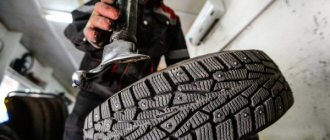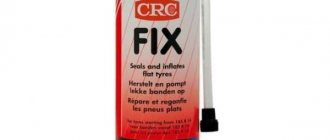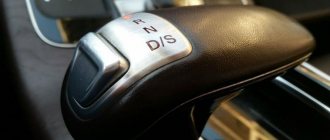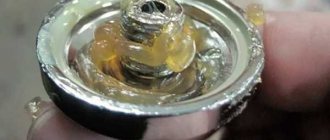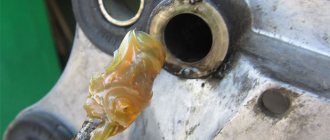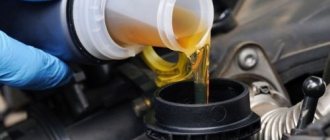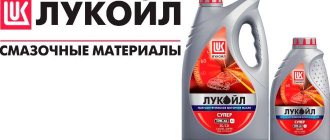“The car loves affection, warmth and lubrication” - the garage saying is absolutely true. Proper car care largely depends on the timely and correct lubrication of the relevant components. The same solutions are not suitable for all components and mechanisms without exception. You can’t get by with just one universal lubricant.
Technologies do not stand still and silicone materials are used everywhere today. But some 20 years ago no one knew about them; graphite lubricant and grease were like a panacea for motorists.
Here is the best material about what silicone lubricant is, what types of lubricants are now available and how to use it
What is silicone grease
Silicone grease is a mixture based on silicone oil with the addition of many components.
The product is available in both creamy form and spray cans.
The main advantages of silicone are the following qualities:
- Silicone grease can be used at any negative and positive temperatures. Ideal for areas with constant heat. At low temperatures it does not lose its fluidity.
- The lubricant is not flammable, so it is not afraid of accidental sparks and open fire.
- Does not conduct electric current. It is an excellent insulator.
- Excellent protection against corrosion.
- Silicone adheres equally well to objects made of plastic, metal, glass and various polymers.
- The composition is absolutely safe for humans and does not cause allergic reactions on the skin or in the respiratory tract.
- Silicone grease is chemically inert - it will not loosen or soften the rubber and will not harm the plastic, while creating a continuous protective layer of polymer on the surface.
- The film that appears after application does not allow water to pass through and repels it.
Application area
Silicone grease is used to lubricate plastic and rubber body parts and vehicle trim parts. Thanks to its high fluidity, the aerosol is able to reach the most inaccessible places on the body and inside the car.
Some cans use a special small-diameter tube to lubricate hard-to-reach areas.
The use of the product may be useful in the following cases:
- For the care of car trim parts. The protective film created as a result of applying lubricant perfectly protects the plastic from ultraviolet rays. In addition, the lubricant can restore the plastic to some extent, especially its color.
- The silicone composition is neutral to soft and porous materials; it does not change their structure and does not corrode.
- To eliminate squeaking and grinding noises. Applying lubricant to various rubbing parts of the car will help eliminate squeaks, as well as extend the service life of the rubbing parts.
- Due to its frost resistance and the absence of water, silicone grease prevents locks from freezing and also protects against corrosion and rust.
- Used to care for rubber seals and wiper blades. Thanks to silicone, rubber acquires its original elasticity. Once the material is absorbed, the wipers will not leave marks on the windshield.
- For lubricating the side surfaces of tires, as well as during their off-season storage.
- Silicone grease is non-conductive, so it is well suited for insulating electrical contacts, such as battery terminals, to protect against moisture and oxidation.
- Due to the fact that silicone ointment is non-conductive, it perfectly improves the dielectric properties of insulation in conditions of high humidity, and also prevents current leakage, leading to interruptions in engine operation and difficult starting.
- Rubber mats and rims are treated for additional protection against dirt.
https://autodont.ru/body/silikonovaya-smazka
Silicone-containing compounds
Despite the fact that silicone compounds have been known to man since 1900, silicone-containing products have become widespread literally over the last 20 years. Today, silicone is used to make many useful things, from waterproof sealants to baking molds for baked goods.
But silicone is most familiar to motorists in the form of a hydrophobic lubricant that protects the rubber parts of the car.
Silicone can also be used to treat any plastic, vinyl and leather surfaces, and most importantly, silicone does not react chemically with the surfaces being treated, so silicone will not harm your car, even if it gets on the paintwork.
In general, wide applicability and complete harmlessness have made silicone lubricant one of the main tools in a motorist’s kit, and probably for this reason every self-respecting manufacturer of automotive chemicals began to produce such lubricants.
On the one hand, this is good, since there is a large selection, but on the other hand, when there are 20 cans on the display labeled silicone, it is difficult for the consumer to understand what the differences are between them and which one is the best. And it is this question that we will now try to answer.
Release forms
First you need to pay attention to the type of container. Typically, silicone can be sold in the form of an aerosol, a trigger, and a bottle with an applicator. Aerosol silicone is the most widely used because it is the easiest to apply.
But the aerosol does not always provide accurate and accurate distribution, this is especially noticeable when processing door seals, when some of the silicone ends up on the paintwork or fabric upholstery.
Despite the fact that silicone does not react chemically with treated surfaces, greasy stains may remain on the fabric upholstery.
Therefore, silicone in the trigger can be a replacement for the aerosol. The absence of high pressure in the bottle will allow you to apply the product more carefully. After application, it is advisable to rub the silicone into the surface using a dry soft cloth, but you can purchase silicone with a foam sponge, which allows you to simultaneously apply silicone and rub it into the surface.
What does it consist of?
The main active ingredient in silicone grease is silicone, which is a compound of silicon and oxygen. Based on its molecular structure, silicone is divided into three groups: silicone liquids, silicone elastomers and silicone resins.
Silicone resins have the highest number of organic groups on silicon atoms among the selected samples. We found silicone resin in only two products - Runway and RW6085 AutoDoctor AD9626.
- But the basis of Runway RW6131 and XADO MOTTEC UNIVERSAL XM 10005 lubricants is the so-called “silicone oil”, which belongs to the group of silicone liquids and has the smallest number of siloxane units.
- In general, “silicone oil” is one of the varieties of the name of the food additive E900, or as it is also called dimethylpolysiloxane. And it is dimethylpolysiloxane that is included in the Hi-Gear HG5501 and StepUp SP5539 lubricants, which indicates that they are made based on silicone liquid and not resin.
- Manufacturers such as VERYLUBE, Dannev and LIQUI MOLY, when indicating the composition of their lubricants, limited themselves to simply the word silicone, without providing more accurate information about which group it belongs to.
- At the same time, Sonax, Bizol and K2 have completely moved away from the concept of silicone and in their composition you can find words such as carbon, hydrocarbon, petroleum and all kinds of gases and organic solvents.
- But the most interesting composition was Hi-Gear HG5502 lubricant. It contains only four substances: propane, butane, heptane, isopropanol and there is not a single word about silicone or silicon.
It turns out that either the composition is indicated incorrectly, or they are trying to sell us a mixture of gases under the guise of a lubricant.
- But there are also manufacturers who decided to go even further, for example, Dynamax, Xado, Mannol and Cobra, the composition is not specified at all. Yes, there are inscriptions on the bottle that there is silicone lubricant inside, but the inscription on the label and the clearly stated composition are two big differences.
Rating of silicone lubricants for rubber seals
Let's look at several silicone lubricants that are quite widespread in Russia.
- Hi-Gear HG. Silicone multifunctional lubricant based on silicone oil. Used in a wide range of applications, including processing rubber seals. Available in 284 g aerosol cans. It costs around 400 rubles per cylinder. It has proven itself as an effective remedy for combating freezing of door seals in winter.
- Liqui Moly Pro-Line Silicon-Spray . Multi-component silicone grease. Created on the basis of a mixture of various silicones and volatile gases. It is produced in a convenient 400 ml bottle with a movable extension tube. The approximate price is 500 rubles per bottle. Collected a lot of positive feedback from car owners.
- Runway 6031 . A relatively simple, but also quite reliable lubricant for protecting rubber products from freezing. Made on the basis of silicone liquid. Sold in small bottles with a 50 ml roller applicator. Price – 120-130 rubles.
- Runway 6085. A more convenient version of silicone grease from this manufacturer for processing large surfaces. The base is silicone resins. Runway 6085 lubricant has positive reviews online from car owners. Sold in aerosol cans with a capacity of 400 ml. The price starts from 260 rubles.
- AutoDoctor. Silicone resin based lubricant. Release form: 150 ml aerosol can. Costs approximately 250 rubles. According to reviews from motorists, this version of silicone grease subjectively creates a thicker layer. On the one hand, thick lubricant gives additional confidence that the rubber bands will not freeze to the doors even in severe frosts. On the other hand, seals shiny with silicone not only look unsightly, but can also stain clothes if you get in and out carelessly.
- Sonax silicone grease. Positions itself as a multifunctional professional team. For a half-liter aerosol can you will have to pay about 650 rubles. In addition to processing rubber seals, it is also used for preserving products made of plastic, metal, rubber and wood, processing ignition coils and high-voltage wires, and also as a polish. Operates in a wide temperature range: from –30 to +200 °C. The only drawback is the high price.
All of these products have proven effective when used as a water-repellent lubricant for treating rubber car door seals.
Automotive silicone
One type of lubricant is silicone grease. Like other types, this lubricant has found wide application in various types of vehicles, including automobiles.
Types of silicone lubricants
There is the following classification into types according to the physical state of this type of lubricant:
- Aerosol.
- Liquid.
- Gel-like.
- Plastic or pasty.
Aerosol lubricant
It is made in a can that is filled with spray. This form of application is easy and not difficult, but there is one drawback - it gets on neighboring elements, since substances under pressure have a wide spray radius.
In this case, it is necessary to cover adjacent elements that should not be exposed to aerosol. You can cover it with masking paper tape, like builders do when painting.
Another feature of using aerosol silicone is the need to immediately rub the sprayed substance. If you don't rub it, greasy stains will remain on its surface.
Liquid
This classic form of release is convenient and effective to use. Due to its liquid state, such a lubricant penetrates into hard-to-reach places of complex-shaped parts made of rubber, plastic, lock cylinders, and door hinges. In addition, when using liquid lubricant, adjacent parts do not get dirty.
Gel-like compositions
This thick form of silicone lubricant for cars is very convenient when applied to various surfaces. Effectively protects plastic products.
Silicone grease or paste
Due to its thick shape, it is quite inconvenient to use for lubrication in hard-to-reach places. Therefore, you should not buy it for lubricating door hinges, lock cores and other parts of complex shape.
All types differ in their state of aggregation (liquid, airy, thick, plastic) and in their area of application. Therefore, it is recommended to read reviews about what is best for such and such parts and which company is better to purchase.
Application
Silicone lubricants in cars are used, for example, to lubricate plastic surfaces that creak when rubbed. In addition to eliminating squeaks, such a lubricant protects the surface of the product and restores color.
Due to such characteristics as frost resistance, it can be effectively used for lubricating locks in winter. If you use an aerosol or liquid type for locks, the lock cylinder (core) will be completely lubricated and will work properly even in cold weather.
Also, rubber door seals are lubricated with silicone grease. It preserves the integrity of the rubber and does not compromise its elasticity.
Lubricating car door hinges with silicone lubricant will eliminate unpleasant squeaking when opening and closing doors.
When a properly selected type of silicone grease is applied to plastic, a protective film will be created on the surface of the parts being processed, which both protects and adds shine.
Another good benefit of using one of these types of lubricant is for lubricating car tires. This is effective when car tires are stored for a long time, and so that they do not become outdated or crack, by lubricating them, they will retain their properties.
Lubricants
Produced on a natural silicone base with the addition of various components and impurities, silicone lubricant has several packaging options (spray, gel, liquid, paste). Relatively recently, the compositions have found wide application in transport technology.
Classification
According to its state of aggregation, silicone grease is divided into the following types:
- Aerosol - comes in a can in the form of a spray, which is easy to apply, but has one unpleasant feature: due to the fact that the spray in the can is under high pressure, when sprayed it gets on nearby elements (glass, door trim, clothing) and gets them dirty. In addition, if the aerosol is not rubbed after application, greasy stains will certainly remain on the surface.
- Liquid - very conveniently applied to the surface without contaminating nearby parts. Thanks to its consistency and fluidity, it penetrates into absolutely all hard-to-reach places. Ideal for processing shaped rubber, plastic and resin products, lock cores and door hinges.
- Thick silicone lubricant for cars has a gel consistency, is easy to apply, and provides reliable protection for plastic surfaces.
- Plastic (paste-like) mixture. Its only disadvantage is that such a lubricant, due to its aggregate state, does not penetrate well into hard-to-reach places. Therefore, it has less versatility and is not suitable for lubricating door hinges and locks.
It is quite difficult to choose a specific type, since each of them has its own area of application and positive reviews. In fact, they differ only in composition, smell and application methods.
Application area
Silicone grease, regardless of its physical state, is used in various parts of vehicles.
- For example, it is applied to rubbing parts made of plastic, where it not only performs a protective function and renews the color of the coating, but also allows you to get rid of the annoying squeaking of plastic.
- Also, silicone grease is ideal for treating locks in winter, since it has a frost-resistant composition.
- The composition additionally ensures ease of opening locks, since due to its consistency it penetrates into the most inaccessible parts of the mechanism.
In addition, rubber door seals are treated with silicone lubricants, which allows them to maintain their integrity for a long time due to the fact that this “miracle thing” maintains the constant elasticity of the seals.
And if you lubricate the car door hinges with silicone-based lubricant, they will stop squeaking and work better.
Due to the content of silicone components, a kind of protective film is formed on the surface of plastic parts, which restores and maintains the presentable appearance (gloss and color) of the coating.
Another area of application of silicone lubricant is the treatment of car tires before long-term storage, since it can stop the aging process of rubber and protects it from drying out.
Advantages and disadvantages of silicone lubricants
Silicone-based lubricants have excellent consumer properties and are truly universal.
Here are the most significant advantages of silicone lubricants over other types of lubricants:
- Frost resistance
- Compatible with most construction materials
- Water resistance
- Exceptional heat resistance
- High dielectric properties
- Oxidation stability
- High lubricity
- Excellent release properties
- Provides the treated surface with reliable protection against corrosion
- Safety for human health
- Excellent anti-friction properties
- Fire safety - silicone grease is not a flammable substance
- Light color that does not impair the aesthetic appearance of the lubricated units
However, before deciding to use silicone lubricant, you must also consider its weaknesses.
The main disadvantage of silicone lubricants (which in many cases turns into an undeniable advantage) is their very poor washability with water and various solvents. Paints and varnishes do not adhere very well to the silicone layer. And this is the main reason that some automakers refuse to use silicone compounds in the production process.
Another drawback is the relatively low load-bearing capacity. That is why lubricant is used only in low-power mechanisms.
Short review
As part of the publication, it is necessary to provide the main properties of products from well-known manufacturers, since this will help most people decide on the choice of a suitable lubricating silicone fluid.
- StepUp is an American manufacturer of auto cosmetics. Silicone grease from this company provides maximum protection for rubber seals, operating in a temperature range from -50 to +200°C. For ease of application, the aerosol can is equipped with a special spray tube.
- Eltrans is a domestic silicone grease that is suitable for use in any temperature condition. Its distinctive feature is the presence of flavoring in the composition, which allows you to completely get rid of the specific odor.
- BBF - the products of this Russian manufacturer restore the color of the coating of plastic and rubber elements in the car, covering them with a thin, shiny, transparent, water-repellent film. The can has a convenient spray.
- HORS is another product produced by us, which is good because after drying, the lubricant layer remains on the surface for a long time. Its only disadvantages are the characteristic smell and the lack of a convenient sprayer.
- LiquiMoly is a time-tested and internationally proven German manufacturer of high-quality car cosmetics. Gel lubricants are produced in special convenient tubes that facilitate their convenient application. Aerosols have good penetrating abilities.
All of the company's products are resistant to temperature changes, do not have a specific odor and are suitable for use in any climate zone.
- MS-Sport - this silicone lubricant is produced by the Russian company VMPAUTO. It contains fluoroplastic, which is a good dielectric. The product is odorless; its only drawback is that it is difficult to apply, since the gel is very thick.
- Molykote is an aerosol lubricant produced in Belgium, which is also characterized by excellent water-repellent properties, the absence of an unpleasant odor and resistance to weather and temperature factors. Today it occupies a leading position because it has the most durable protective film.
Kinds
Silicone lubricants are available in the form of:
- Spray. This release agent is easy to apply without additional tools.
- Pastas. The thick consistency requires application with a napkin or brush; it does not always get into hidden cavities.
- Gelya. It is better to rub in gel compositions with an applicator to thoroughly treat the entire surface, including invisible cavities and gaps.
- Liquids. A fluid structure is an advantage and a disadvantage at the same time. The liquid lubricates the entire treated area well, but due to natural losses, the consumption of the substance increases.
Silicone lubricants
Autumn and subsequent winter are an excellent reason to purchase silicone lubricant. The main difference between silicone grease and any other is the base. As the name suggests, this is silicone oil. It is very liquid. Even lubricant sprayed from a can contains a thickener.
But there is also a viscous lubricant that looks like lithol. This lubricant is useful for any driver: both a passenger car and multi-ton special equipment.
The silicone base determines the properties of the lubricant. It does not have outstanding tribological characteristics and is suitable for lubrication of auxiliary mechanisms only. But this lubricant does not mix with water at all, has water-repellent properties and is harmless to rubber and plastic. Unlike lubricants based on mineral oils.
It is used in accordance with these properties. Not so much for lubrication, but for preservation and protection. In winter, the problem of car doors freezing is a pressing one. This happens the next day after washing. It seems like you wipe the openings and drive around - you don’t forget to dry the car, but you still come back the next day - not all the locks open.
And the doors are covered with frost. It’s amazing, you spray wd on a frozen castle and it quickly thaws. And if you spray it on something that is not yet frozen, it may not help. To avoid such troubles, you can use silicone grease. You can spray the locks with wd-40 instead.
Applying lubricant to rubber seals is a little more difficult. You need to spray it on a cloth and carefully apply it to the elastic band. Just by spraying from a container you can fill everything around.
Silicone grease applied to the rubber protects it from air access and from drying out. And it simply renews the appearance of rubber and plastic.
On VAZ cars, and probably not only on them, there is such a problem as freezing of the expansion tank valve. When the engine is running, condensation accumulates on the valve, which, when the engine cools, will freeze before the entire volume of antifreeze in the cooling system has cooled. A vacuum is formed and air enters the system through loose connections.
When the engine warms up, on the contrary, the valve will thaw late and increased pressure will form in the system. A little silicone grease won't prevent condensation, but it will allow pieces of ice to jam the valve. Silicone grease will be useful for you at home, for lubricating fittings and seals of plastic windows.
If you find yourself in the country and need to light a fire, silicone grease burns no worse than Wd-40. So is Wd-40 really no longer needed? Of course you need it! Silicone grease will help protect mechanisms from corrosion, but will also help unscrew rusted screws.
https://www.ladatuning.net/pokupaem-vybiraem-prodajom/769-dlya-chego-nuzhna-silikonovaya-smazka
Automotive silicone grease
Silicone waterproof grease is developed by mixing silicone oil and a special thickener. The lubricant is a white translucent substance with a certain degree of viscosity, the quality characteristics of which are determined by the ratio of its constituent components.
Most often, this substance is used to treat rubber components of any mechanisms in order to extend their service life. At the same time, the rubber never loses its original consistency, does not loosen or soften. The substance is often used to protect metal products from corrosion. The product is often used to make thermally conductive pastes.
Types of silicone lubricants used:
- means for rubber seals;
- product with fluoroplastic;
- means for processing oil seals or calipers;
- means for processing plastic gears;
- lithium silicone greases;
- heat-resistant mixture;
- for alternator belt.
Processing of metal products
Bearings are used in a wide variety of mechanisms operating over a fairly wide temperature range. It is for this reason that the use of silicone grease for such components is justified.
Waterproof product made from thickener and silicone oil. The main functional component of silicone grease is polymethylsiloxane.
The distinctive qualities of such a liquid are considered to be inertness, lack of harmful effects on the skin, and explosion safety.
Thanks to the lubricant components, a layer is formed on the treated contacting surfaces, which is a special polymer bond consisting of microscopic fibers that prevents contact of the metal with moisture. Naturally, such a layer is sliding, which significantly softens the friction between the processed components.
Composition and properties of silicone grease
Oils with low viscosity have good fluidity and penetrating ability. More viscous oils adhere better to the surface, but are able to withstand higher loads.
Pure silicone oils can operate in the temperature range -40...+205 °C, however, the introduction of various additives into the composition can expand these boundaries.
Silicone liquids are characterized by chemical inertness, they are compatible with many construction materials (metals, plastics, rubbers, leather, glass, ceramics, etc.), non-flammable and not harmful to humans, subject to the usual rules for working with lubricants. It should be noted, however, that when heated to high temperatures, silicone fluids can release harmful volatile substances.
After application, silicone lubricants are distributed over the surface, forming a fairly durable protective layer that has a high water-repellent effect and reliably protects against corrosion.
Silicone liquids adhere well to surfaces made of glass, plastic, rubber, wood, metal, and have excellent dielectric, thermal conductivity and anti-foam characteristics.
Silicone greases are made by thickening silicone oils with special soaps (usually lithium) or silica. Sometimes the lubricant composition also includes anti-friction fillers, for example, polytetrafluoroethylene (Teflon). Depending on the use of a particular thickener and fillers, these materials obtain certain properties.
Thus, lithium soaps determine the maximum operating temperature of lubricants – +205 °C. The introduction of carbon black, copper phthalocyanine and some other ingredients into the material makes it possible to increase the upper temperature limit to +315 °C.
The description and characteristics of silicone grease can be read on the label, from the seller or on the manufacturer’s website.


